Bread and durum wheat (Triticum aestivum and T. turgidum) were domesticated in the Near and Middle East. Present world production is about 582.7 million tons from 213.8 million ha.(FAOSTAT, 2001).
The crop is grown as a rainfed crop in the temperate climates, in the sub-tropics with winter rainfall, in the tropics near the equator, in the highlands with altitudes of more than 1500 m and in the tropics away from the equator where the rainy season is long and where the crop is grown as a winter crop.
Wheat is grown under irrigation in the tropics either in the highlands near the equator and in the lowlands away from the equator. In the subtropics with summer rainfall the crop is grown under irrigation in the winter months. In the subtropics with winter rainfall it is grown under supplemental irrigation.
The length of the total growing period of spring wheat ranges from 100 to 130 days while winter wheat needs about 180 to 250 days to mature. Daylength and temperature requirements are key factors in variety selection. Varieties can be grouped as winter or spring types according to chilling requirements, winter hardiness and daylength sensitivity. Winter wheat requires a cold period or chilling (vernalization) during early growth for normal heading under long days. Winter wheat in its early stages of development exhibits a strong resistance to frost, down to – 20°C. The resistance is lost in the active growth period in spring and during head development and flowering periods frost may lead to head sterility. Because of this sometimes more damage is done to the winter crop by spring frost than by winter frost.
In areas of severe winters, cold winds and little snow, spring wheat varieties are grown. Spring wheat does not require chilling for heading and it is day-neutral. However, it is also sensitive to frost. For winter and spring wheat minimum daily temperature for measurable growth is about 5°C. Mean daily temperature for optimum growth and tillering is between 15 and 20°C. Occurrence of (spring) frost is an important factor in selection of sowing date. A dry, warm ripening period of 18°C or more is preferred. Mean daily temperatures of less than 10 to 12°C during the growing season make wheat a hazardous crop. Knowledge of genetic characteristics and particularly the growth and development pattern of wheat varieties is essential for meeting the combination of various climatic requirements for growth development and yield formation.
The crop can be grown on a wide range of soils but medium textures are preferred. Peaty soils containing high sodium, magnesium or iron should be avoided. The optimum pH ranges from 6 to 8. For good yields the fertilizer requirements are up to 150 kg/ha N, 35 to 45 kg/ha P and 25 to 50 kg/ha K.
Wheat is relatively tolerant to a high groundwater table; for sandy loam to silt loam a depth of groundwater of 0.6 to 0.8 m can usually be tolerated, and for clay 0.8 to 1 m. For short periods the crop can withstand without visible harm a minimum depth of 0.25 m. With a rise of groundwater table to 0.5 m for long periods the yield decrease is 20 to 40 percent.
The crop is moderately tolerant to soil salinity but the ECe should not exceed 4 mmhos/cm in the upper soil layer during germination. Yield decrease due to salinity is 0% at ECe 6.0, 10/ at 7.4, 25% at 9. 5, 50% at 13 and 100% at ECe 20 mmhos/cm.
With pre-irrigation or sufficient rain to wet the upper soil layer, seeds are drilled 2 to 4 cm deep. as against 5 to 8 cm in dry soils, so that light showers will not cause the seeds to germinate. Under favourable water supply including irrigation and adequate fertilization row spacing is 0.12 to 0.15 m (450 to 700000 plants/ha) but increases to 0.25 m or more under poor rainfall conditions (less than 200000 plants/ha). Sowing rates under irrigation are 100 to 120 kg/ha (drilled) to 110 to 140 kg/ha (broadcast). Wheat is often grown in rotation and legumes, sunflower and maize are considered as suitable rotation crops.
The graph below depicts the crop stages of wheat, and the table summarises the main crop coefficients used for water management.
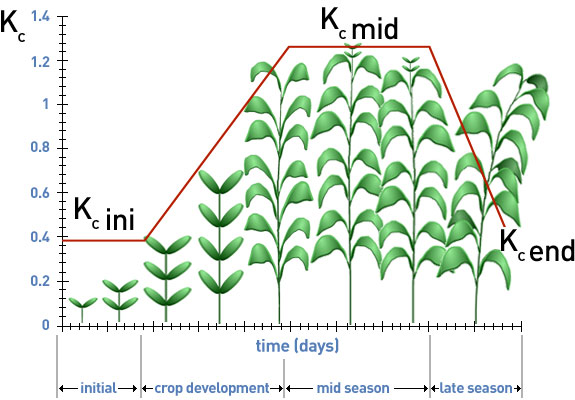
Stages of Development | Plant date | Region | |||||
|---|---|---|---|---|---|---|---|
Crop | Initial | Crop | Mid–season | Late | Total |
| |
Stage length, days |
|
|
|
|
|
|
|
Depletion |
|
|
|
|
| ||
Root Depth, m |
|
|
|
|
|
| |
Crop Coefficient, |
|
|
|
| – |
|
|
Yield Response |
|
|
|
|
| ||
1These periods of winter wheat with lengthen in frozen climates according days having zero growth potential and wheat dormancy. Under general conditions and in the absence of local data , fall planting of winter wheat can be presumed to occur in northern temperate climates when the 10-day running average of mean daily air temperature decreases to 17°C or Decenmber 1, whichever comes first. Planting of spring wheat can be presumed to occur when the 10-day running average of mean daily air temperature increases to 5°C. Spring planting of maize-grain can be pressure.
2The higher value is for hand-harvested crops.
For high yields water requirements (ETm) are 450 to 650 mm depending on climate and length of growing period. The crop coefficient (kc) relating maximum evapotranspiration (ETm) to reference evapotranspiration (ETo) is: during the initial stage 0.3-0.4 (15 to 20 days), the development stage 0.7-0.8 (25 to 30 days), the mid-season stage 1.05-1.2 (50 to 65 days), the late-season stage 0.65-0.7 (30 to 40 days) and at harvest 0.2-0.25.
Following figure shows growth periods of winter and spring wheat (Large, 1954)
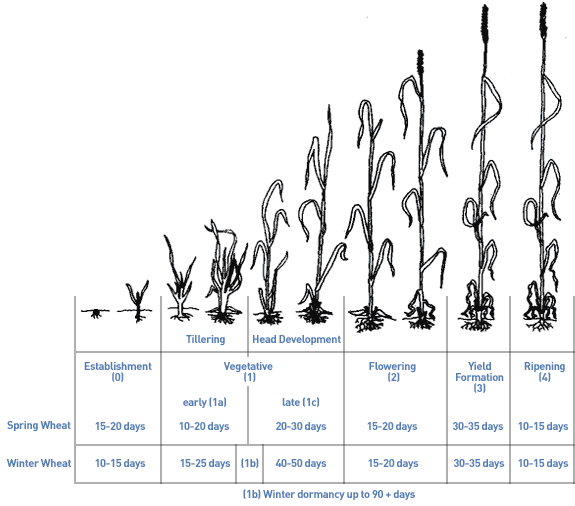
The relationships between relative yield decrease (1 – Ya/Ym) and relative evapotranspiration deficit for the total growing period of spring wheat are shown in the figure below.
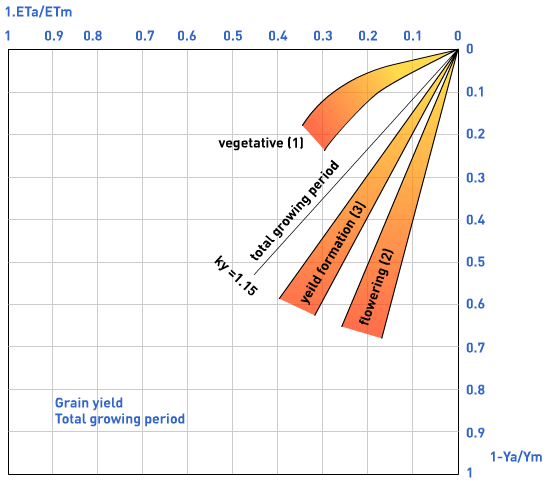
The relationships between relative yield decrease (1 – Ya/Ym) and relative evapotranspiration deficit for the total growing period of winter Wheat are shown in the figure below.
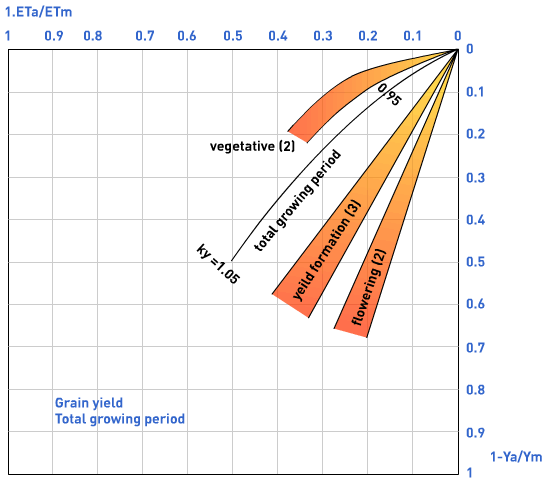
This figure shows the relationships between relative yield decrease (1 – Ya/Ym) and relative evapotranspiration deficit for the individual growth periods.
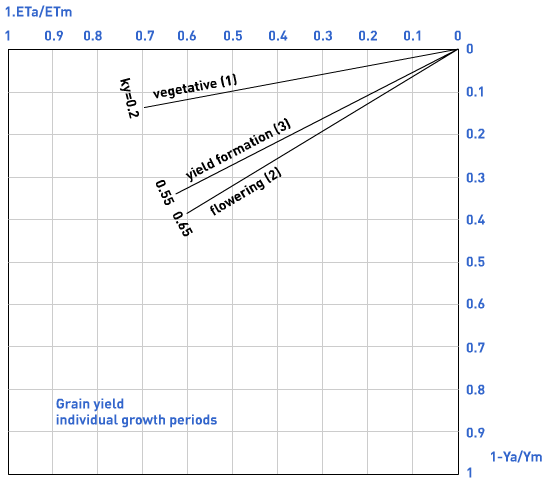
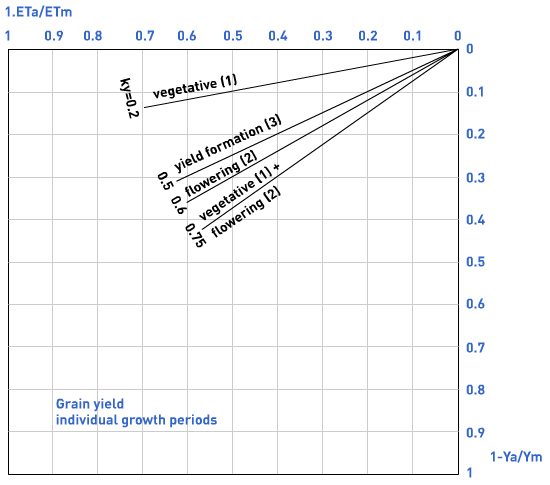
Grain yield and grain straw ratio are-related to the duration and intensity of water deficit but the relations vary depending on the growth period during which the deficits occur. There is, however, some variation in variety as to the magnitude of the resulting yield decrease.
The relationships indicate that sensitivity to water deficit is somewhat higher in spring that in winter wheat, and this difference is thought to be the result of ‘conditioning’ of winter wheat which enables it to adjust its growth better in relation to water deficit.
For most varieties and particularly for the high producing varieties, early irrigation or heavy pre-and early season rain can produce good yields particularly when soils are deep and have a good water holding capacity and with an adequate amount of stored soil water, significant water deficits may occur only in the yield formation period (3). Only with irrigation or rain in the early growth periods (0 and 1a) plant and head number per m2 are considered higher compared to no rain or irrigation. In the latter situation the time to heading is also usually shortened.
Slight water deficits in the vegetative period (1) may have little effect on crop development or may even somewhat hasten maturation. The flowering period (2) is most sensitive to water deficit. Pollen formation and fertilization can be seriously affected under heavy water stress and during the time of head development and flowering water shortage will reduce the number of heads per plant, head length and number of grains per head. At the time of flowering root growth may be very much reduced and may even cease and considerable damage can be caused in this period. The loss in yield due to water deficits during the flowering period (2) cannot be recovered by providing adequate water supply during the later growth periods.
Water deficit during the yield formation period (3) results in reduced grain weight and hot, dry and strong wind in combination with a water deficit during this period causes shrivelling of grain. During the ripening period (4) a drying-off period is often induced by discontinuing irrigations and water deficit during this period only has a slight effect on yield.
In summary, provided there is adequate water during the establishment period (0) the critical periods for water deficit are:
Wheat has the ability to form additional tillers when heavy water stress during the late vegetative period (1c) is followed by heavy water application. Yields may be improved through the formation of additional heads but harvest is delayed and losses from other causes such as lodging and non-uniform ripening are often increased.
Following figure shows critical periods for water deficit of wheat
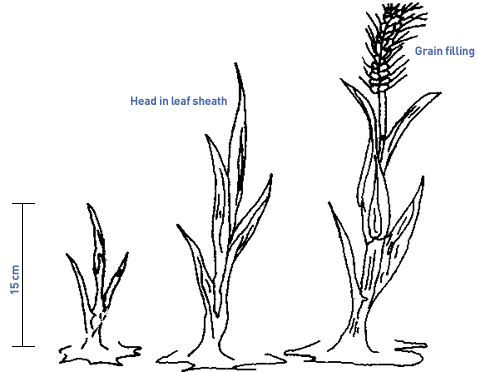
Wheat has a primary system and later it develops a fibrous root system. The latter roots are formed from the nodes which are at or near the ground surface. Depth and density of rooting are affected by water, nutrients and oxygen in the soil. In deep soils, the active rooting depth for spring wheat is 0.9 m with a maximum of 1.2 to 1.5 m and a spread of 0.15 to 0.25 m in all directions. For winter wheat, active rooting depth is up to 1.2 m with maximum of 1.5 to over 2 m and a similar spread. The top root ratio increases with crop development and is about 2 during the vegetative period (1), about 4 before heading, and about 10 to 11 during the yield formation (3) and ripening (4) period. In winter wheat the primary root system is developed in the autumn and full rooting depth in the spring is reached earlier than in spring wheat which requires 50 to 75 days after emergence to reach full depth.
Water uptake and extraction patterns are related to root density. In general 50 to 60 percent of the total water uptake occurs from the first 0.3 m, 20 to 25 percent from the second 0.3 m, 10 to 15 percent from the third 0.3 m and less than 10 percent from the fourth 0.3 m soil depth. Normally 100 percent of the water uptake occurs over the first 1.0 to 1.5m (D = 1.0-1.5m). Under conditions when maximum evapotranspiration is about 5 to 6 mm/day water uptake of the crop is little affected at soil water depletion of less than 50 percent of the total available soil water (p = 0.5). Moderate water stress to the crop occurs at depletion levels of 70 to 80 percent and severe stress occurs at levels exceeding 80 percent.
Taking into account ETm, for non-stress conditions about 50 to 60 percent of available soil water can be utilized by the crop before the next irrigation, with somewhat higher depletion levels during the.ripening period (4). There is a distinct advantage for both winter and spring wheat in having the entire root zone filled to field capacity prior to or soon after sowing to attain optimum root development. Over watering during the vegetative period (1) produces luxurious growth that can cause lodging, which may also occur after a too heavy irrigation in the late yield formation period (late 3), particularly with sprinkler irrigation.
Where rainfall is low and irrigation water supply is limited, in addition to preirrigation, applications should be scheduled to avoid water deficits during the flowering period (2) and at about 50 to 70 days after sowing of spring wheat. Irrigation and rainfall during the late yield formation period (late 3) show little effect on yields when sufficient soil water in the root zone is carried over from the previous period to see the crop into the ripening period.
To irrigate a large area most efficiently with limited water supply: one heavy autumn irrigation to wet the full root zone during September-November, one spring irrigation and one irrigation in the flowering period (2).
High yield with one full irrigation and one to four spring irrigations with soil water depletion-in the first 1 m soil depth not exceeding 70 percent of the total available water.
One irrigation during the establishment period (0) but still beneficial when applied as late as the flowering period.(2). With two irrigations, highest yields when applied during early vegetative (la) and flowering periods. With three irrigations the additional application is given at the late vegetative period (lc) but the effect on yield between two and three spring irrigations may be small.
Sowing in dry soil with application of 150 min after sowing; in the case of substantial rain, irrigation should bring the upper 0.6 m to field capacity. The second irrigation is applied when water depletion in the upper 1 m has reached 100 to 120 mm. In average years no further irrigation is required until heading. If at flowering (heading) soil water depletion is less than 30 mm, irrigation can be delayed until early yield formation period (early 3) when the first 0.6 m is brought to field capacity. If at heading soil water depletion is greater than 50 mm irrigation should be applied at that time with no further irrigation afterwards.
During early growth adequate water should be available in the soil profile and one application of 150 mm is recommended. Winter rains of 250 mm are usually adequate to bring the crop to maturity. At flowering 150 mm of available soil water should be stored in the root zone; when smaller, an additional irrigation is required.
In addition to pre-irrigation, one irrigation during early vegetative period (la); two irrigations – one during early vegetative period (1a) and one just prior to head emergence through flowering period (2); three irrigations – during early vegetative period (1a), just prior to head development through flowering period (2) and early yield formation period (early 3); four irrigations – during early vegetative (1a), late vegetative (1c), flowering (2) and early yield formation (early 3) periods.
Under irrigation a good commercial grain yield is 6 to 9 ton/ha (10 to 13 percent moisture). The water utilization efficiency for harvested yield (Ey) for grain varies then between 0.8 and 1.6 kg/m3.
